In this article:
You probably imagine soft candles, relaxing music, a soothing bath and a divine fragrance in the air when you think of essential oils. Famed and lauded for their cathartic effects on the body and mind, essential oils are fast gaining traction as much more than just aromatherapy agents.
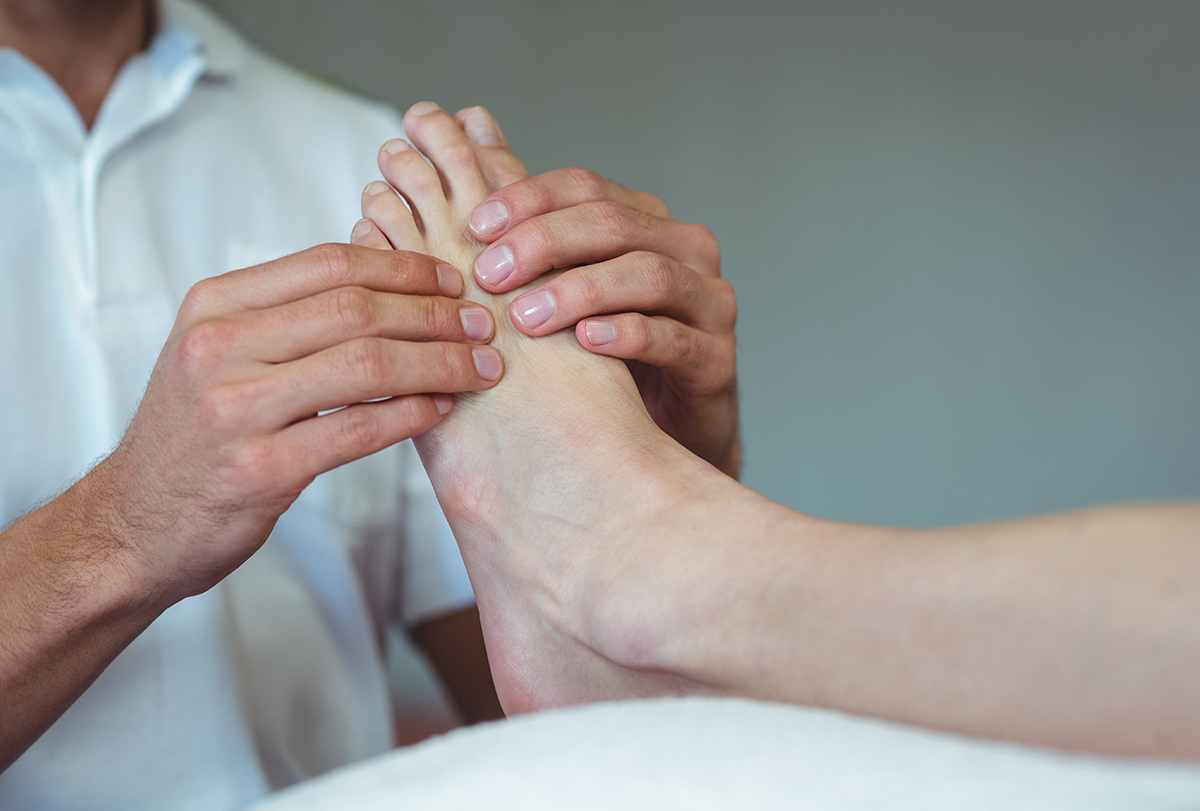
Backed by a growing body of scientific research, these natural elixirs are now being recognized for their pharmaceutical, nutritional and cosmetic applications, primarily due to their potent antimicrobial, antioxidant, anticancer, and anti-inflammatory activities.
There are a number of bodily discomforts and physical ailments that fall within the purview of essential oil’s pharmacological uses. For instance, essential oils work wonders in soothing swollen ankles and feet and bringing them back to their normal state.
Our feet take a regular beating, bearing the brunt of our body weight throughout the day. This sustained overexertion, in turn, makes the most laborious parts of our body vulnerable to all kinds of internal and external wear and tear. No surprise then that swollen feet and ankles are one of the most common health afflictions that plague people around the world.
While the swelling may stem from a number of causes like undue pressure, prolonged inactivity, and injury, among others, it essentially indicates constricted blood flow to and from the feet leading to fluid retention in the feet or ankles which is often extremely painful.
How to Use Essential Oils for Treating Swollen Ankles and Feet
Here’s how you can use essential oils to treat swollen ankles and feet.
1. Blended massage therapy
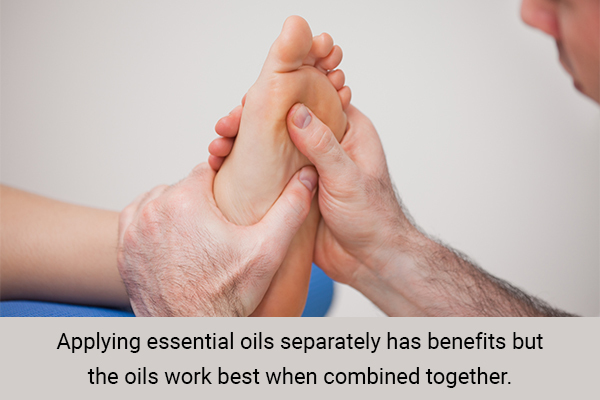
Applying essential oils separately has benefits but the oils work best when combined together. The properties of each essential oil complement the other thereby forming a therapeutic mix that possesses incredible healing abilities.
Caution: Do not apply pure essential oils directly on the skin. Always mix them with some kind of carrier oil that will make these essential oils safe for skin application and increase their capacity to penetrate into the affected areas well.
Here are some essential oil blends you can try.
a. Lemongrass, grapefruit, and cypress blend
All three of these essential oils possess anti-inflammatory properties and work on the swollen area within a matter of minutes. (1)
A 2014 study published in the International Journal of Molecular Medicine found that lemongrass essential oil, with its citral and geranial constituents, is a therapeutic candidate for allergic and inflammatory diseases due to its inhibitory effect on inflammatory responses. (2)
How to use:
- Put 1 ounce (2 tablespoons) of melted coconut oil (preferably fractionated) in a small jar.
- Add 2 or 3 drops each of lemongrass, grapefruit, and cypress essential oils. Optionally, you can put 10 drops each of these essential oils in a separate bottle or bowl and shake or mix it well. Using a dropper, add 6 to 8 drops of the blended oils to the carrier coconut oil.
- Mix the ingredients together with a toothpick.
- Apply the mixture on the affected area and massage for 5 to 10 minutes.
- Repeat 2 or 3 times daily.
Additional tips:
- While these three essential oils work wonderfully, you can also add 10 drops each of geranium, fennel, and juniper berry essential oils if you have them handy.
- You may substitute the fractionated coconut oil with sunflower or canola carrier oil.
- Put those feet up! Remember, swollen feet and ankles are most often due to poor blood flow. Keep your feet up every time while using these oil treatments
b. Eucalyptus, peppermint, and lemon blend
This is an effective blend for those who not only have swelling but also experience a great deal of pain. All these essential oils are anti-inflammatory and terrific pain relievers.
A 2003 study published in the Journal of Ethnopharmacology reported that eucalyptus essential oil exhibits central and peripheral analgesic effects as well as neutrophil-dependent and independent anti-inflammatory activities. (3)
A 2014 study published in PLOS One reported that menthol essential oil had potent anti-inflammatory activity in the croton oil-induced mouse ear edema model and demonstrated moderate antioxidant activity. (4)
Similarly, another 2014 study published in PLOS One reported that the essential oils obtained from Citrus limon and Citrus limonia also demonstrate a significant anti-inflammatory effect. (5)
Owing to their incredible relaxing properties, these oils come together beautifully to create a soothing concoction.
According to a 2013 study published in Evidence-Based Complementary and Alternative Medicine, (6) Eucalyptus essential oil is effective in reducing inflammation, pain and swelling in patients who underwent a knee replacement operation,
Furthermore, the pain-relieving and swelling-reducing properties of peppermint essential oil are widely acknowledged for the treatment of arthritis. (7)
Lemon is considered one of the strongest anti-inflammatory essential oils and is also used to treat swelling due to arthritis.
How to use:
- Put 1 ounce (2 tablespoons) of melted coconut oil (preferably fractionated) in a small jar.
- Add 2 or 3 drops each of eucalyptus, peppermint, and lemon essential oils in it.
- Mix the ingredients together with a toothpick.
- Apply the mixture on the affected area and massage for 5 to 10 minutes.
- Repeat 2 or 3 times daily.
Additional tips:
- Add 2 or 3 drops of lavender essential oil for added fragrance and relaxation.
- You can substitute eucalyptus with tea tree oil, another potent anti-inflammatory agent. If you suspect an infection, tea tree oil will be especially effective due to its antibacterial and antifungal properties.
2. Foot baths
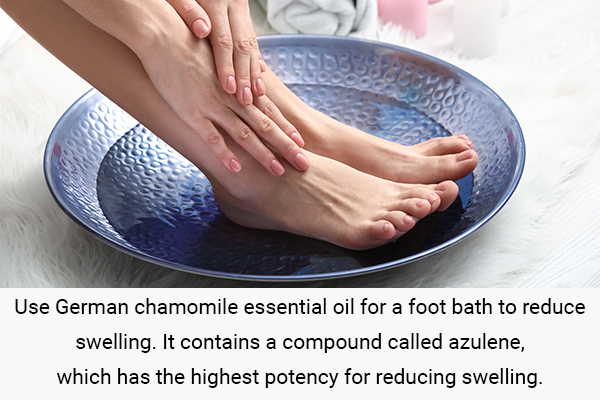
You can try using these foot soaks for relief from swelling in the feet and ankles.
a. Chamomile essential oil soak
Chamomile essential oil is known for its medicinal benefits. It is effective in reducing inflammation, soothing the nerves, relieving pain, and flexing aching muscles. Moreover, the oil was found useful in reducing external swelling by a 2011 study published in Molecular Medicinal Report. (8)
There are different varieties of chamomile essential oil. Make sure you use the German chamomile essential oil for a foot bath to reduce swelling. It contains a compound called azulene, which has the highest potency for reducing swelling.
How to use:
- Fill a small or medium tub with warm water.
- Add 5 to 10 drops of chamomile essential oil to it.
- Soak your feet for 10 minutes or as long as the water stays warm.
- Repeat at least 2 or 3 times daily.
b. Wintergreen essential oil soak
Wintergreen is a lesser-known but highly potent essential oil to reduce swelling and relax sore ankles and feet. It is a terrific pain reliever and is used widely to treat a variety of conditions such as headaches, muscle pain, and painful ankles or feet. (9)
It can be paired with other essential oils such as cypress, peppermint, lemongrass, geranium, and lavender, for extra benefits.
How to use:
- Fill a small or medium tub with warm water.
- Add 2 or 3 drops of wintergreen essential oil to it. Since wintergreen oil has strong potency, a small quantity would suffice. It’s important to avoid overuse.
- Add 5 to 8 drops of lavender, cypress, peppermint, lemongrass, or geranium essential oil to it.
- Soak your feet for 10 minutes or as long as the water stays warm.
- Repeat at least 2 or 3 times daily.
Additional tips:
- If you have swollen ankles, you can put pebbles or stones at the bottom of the tub and rub your soles over them for extra relaxation. Do not do this if you have swollen feet as it could aggravate the pain.
- You can dry your feet, put them up, and then massage the affected area with any of the essential oil blends described above, mixed in a carrier oil for added relief.
3. Individual application
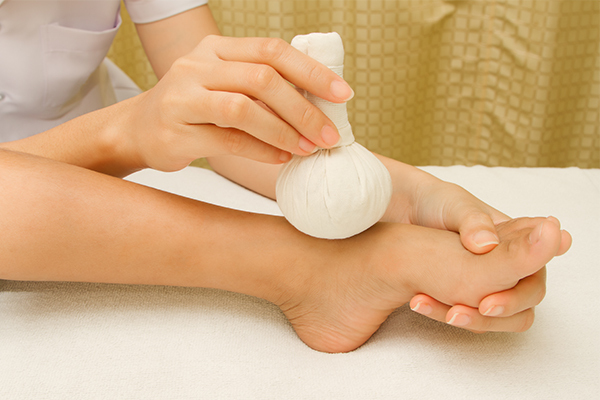
If you do not have time to prepare a foot bath, do not have a blend at your disposal or are in too much pain and need quick relief, you can apply individual essential oils on the affected areas.
Again, remember to dilute pure essential oils with a carrier oil – such as fractionated coconut oil, sunflower oil, calendula oil or any vegetable oil – as directly applying pure essential oils can be unsafe.
You can use any of the popular anti-inflammatory and pain-relieving essential oils such as tea tree, (10) grapefruit, peppermint, juniper, (11) chamomile, eucalyptus, thyme, (12) and rosemary. (13)
Simply add 12 drops of any of these essential oils to 2 tablespoons of a carrier oil, and mix well. Massage the affected area with the oil mixture for 5 to 10 minutes. Repeat at least 2 or 3 times daily.
Additional tips:
- After massaging with essential oil, apply a hot compress to your swollen feet and ankles to further improve circulation and reduce swelling.
- You can also use a cold compress to ease extreme pain.
Pharmacological Functions of Essential Oils
A 2018 study published in Evidence-Based Complementary and Alternative Medicine attributes considerable anti-edematogenic and anti-inflammatory properties of lavender essential oil, both when applied topically or taken orally. (14)
Similarly, another 2005 study published in the Journal of Inflammation found that cutaneous application of essential oils, especially geranium oil can alleviate the inflammatory symptoms caused by neutrophil accumulation and edema. (15)
Causes of Swollen Ankles and Feet
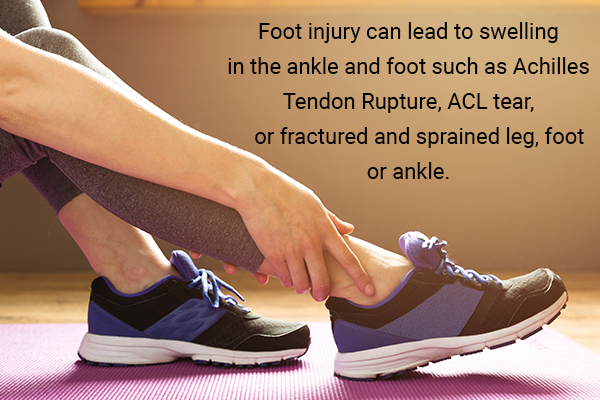
There could be many reasons for the swelling of the ankles and feet, and most of them are usually not a cause for concern.
- It could be triggered by merely walking long distances or sitting with one’s legs hanging in a way that obstructs the blood flow to the feet.
- The condition is also common during pregnancy, as the body is prone to overproduction of blood and bodily fluids as well as excessive fluid retention. Moreover, the hormonal changes and the added weight of the uterus on the veins can worsen this condition.
- In some cases, a foot injury can lead to swelling in the ankle and foot such as Achilles Tendon Rupture, ACL tear, or fractured and sprained leg, foot or ankle. (16)
- Alcohol consumption can also contribute to swollen feet and ankles as it leads to greater water retention in the body. Furthermore, if you show a tendency to develop this problem every time you consume alcohol, it can be an indication of some underlying issue with your liver, heart, or kidney.
- Soaring temperatures can often cause people with circulatory problems to develop swollen feet and ankles. The veins tend to naturally expand to cool off the body; this results in spillage of fluids to the adjoining tissues and in some cases, the inability of the veins to carry blood up to the heart. This, in turn, causes pooling of fluids in the ankles and feet.
- Kidney disorders tend to increase the salt content in the blood, which makes your body susceptible to increased water retention.
- Blood clots in the veins of the leg can obstruct blood flow to the heart and give rise to swelling in the feet and ankles.
Symptoms Associated With Swelling of Ankles and Feet
- There is stiffness or restricted movement.
- The tissue under the skin appears distended or inflamed.
- The skin on the affected area appears stretched and shiny.
- The affected area is discolored.
- The skin temporarily retains a dimple, pit, or impression after being pressed for several seconds.
Tips to Prevent Swelling Around the Ankles and Feet
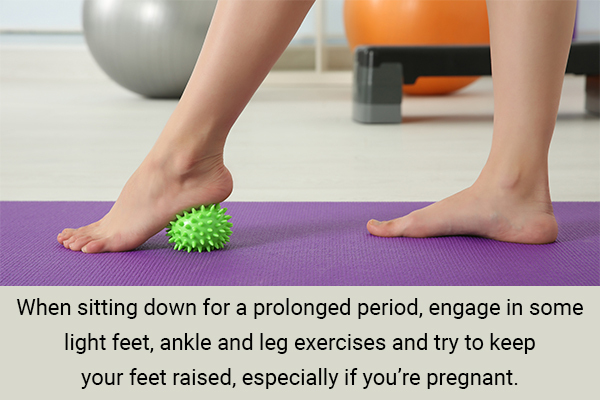
- Cut back on your alcohol intake.
- Manage your weight if you are on the heavier side, and try to keep it within optimum limits.
- Avoid standing for extended periods; take breaks to ease the strain on your feet.
- When sitting down for a prolonged period, engage in some light feet, ankle and leg exercises and try to keep your feet raised, especially if you’re pregnant.
- Elevate your legs above the heart level every now and then to aid blood circulation in your body.
- Incorporate a lightweight workout in the form of cycling, swimming, or brisk walking as a part of your daily routine.
- Keep your body cool by spending time in the pool during the hot summer months.
- If and when you’re about to embark on a rigorous physical exercise, it’s imperative to loosen up your body first by starting with a quick warm up. This helps avert foot and ankle injuries.
- Wear comfortable and supportive footwear that provides your feet with enough room to breathe and do not constrict blood flow. Choose appropriate shoes for your workouts, depending upon the type and intensity of the exercise. Seek professional help if required.
- Stick to a low-sodium diet that helps mitigate water retention in the body.
Over the years, essential oils have attracted much attention in scientific research and are increasingly used in pharmaceutical, nutritional and cosmetic applications. Primarily due to their potent antimicrobial, antioxidant, anticancer, and anti-inflammatory activities.
When to See a Doctor

If the swelling shows no signs of diminishing, you should seek immediate medical attention, as it could be a symptom of a serious underlying disease. For instance, in some cases, swollen feet could indicate infection and illnesses such as liver failure, rheumatoid arthritis, hypertension, and varicose veins. (17)
Excessive swelling during the later months of pregnancy, often accompanied by other symptoms like headaches, nausea, and abdominal pain is a cause for concern and requires prompt medical assistance. (18)
Moreover, certain essential oils must not be used in any form by pregnant women. Thus, when expecting it is advised that you begin any treatment using any essential oil only after running it by your doctor.
Final Word
Please keep in mind that while essential oils will effectively reduce swelling and alleviate pain, they alone cannot offer a permanent and holistic solution to your condition.
Rather, essential oils are to be employed as complementary aids in the treatment and it is imperative that you seek professional help from your healthcare provider if the symptoms fail to subside or recur.
- Was this article helpful?
- YES, THANKS!NOT REALLY


